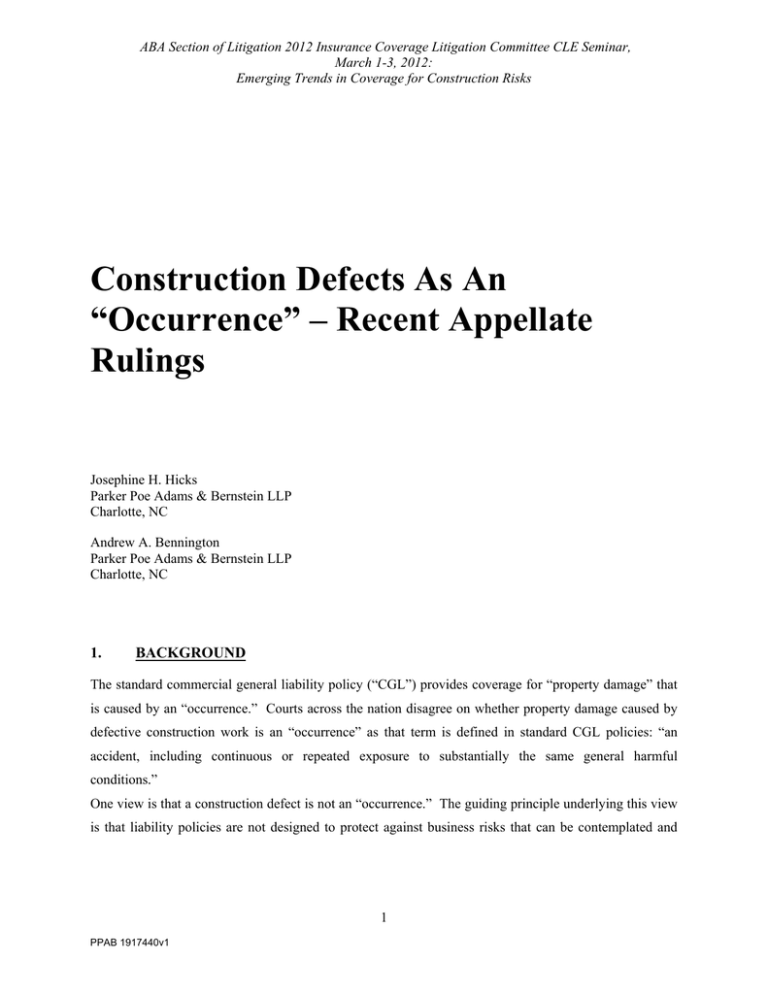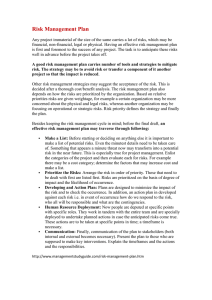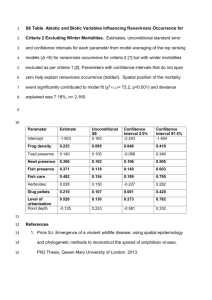Construction Defects As An “Occurrence
advertisement

ABA Section of Litigation 2012 Insurance Coverage Litigation Committee CLE Seminar, March 1-3, 2012: Emerging Trends in Coverage for Construction Risks Construction Defects As An “Occurrence” – Recent Appellate Rulings Josephine H. Hicks Parker Poe Adams & Bernstein LLP Charlotte, NC Andrew A. Bennington Parker Poe Adams & Bernstein LLP Charlotte, NC 1. BACKGROUND The standard commercial general liability policy (“CGL”) provides coverage for “property damage” that is caused by an “occurrence.” Courts across the nation disagree on whether property damage caused by defective construction work is an “occurrence” as that term is defined in standard CGL policies: “an accident, including continuous or repeated exposure to substantially the same general harmful conditions.” One view is that a construction defect is not an “occurrence.” The guiding principle underlying this view is that liability policies are not designed to protect against business risks that can be contemplated and 1 PPAB 1917440v1 mitigated by the insured. 1 Focusing on the definition of “occurrence,” courts adhering to this view have concluded that property damage caused by defective work cannot be accidental because a general contractor should expect that faulty workmanship will cause damage. 2 This analysis may, however, conclude that coverage exists when the defective work results in damage to property other than the insured’s work product. 3 A second view is that construction defects can constitute an “occurrence” if the resulting damage is unexpected by the insured. Under this analysis defective construction can be an “accident” – and thereby an “occurrence” – if the resulting damage is a fortuitous or unintended event. 4 Against this backdrop, this paper surveys recent case law, which demonstrates that the debate over whether damage caused by construction defects constitute an “occurrence” continues. 2. CROSSMAN I AND II The Supreme Court of South Carolina reversed course twice in 2011. It ultimately returned to its position that CGL coverage exists for continuous damage to other property resulting from faulty construction, but not for the cost of repairing the defective work itself. See Crossman Communities of N.C., Inc., et al. v. Harleysville Mutual Insurance Company, et al., 2011 WL 3667598 (S.C. Aug. 22, 2011) (“Crossman II”). a. Crossman I Crossman Communities of North Carolina, Inc., (“Crossman”), the developer of a series of condominium projects in Myrtle Beach, South Carolina, was sued by homeowners alleging that defective construction resulted in water intrusion that caused damage to otherwise nondefective components of the condominium units. In the coverage litigation, the trial court found that the water intrusion was caused by an “occurrence.” The trial court’s decision was consistent with South Carolina Supreme Court rulings in L-J, Inc. v. Bituminous Fire and Maine Ins. Co., 621 S.E.2d 33 (S.C. 2005) and Auto Owners Insurance Co. v. 1 See Cincinnati Ins. Companies v. Collier Landholdings, LLC, 614 F.Supp. 2d 960, 966 (W.D. Ark. 2009); Auto-Owners Ins. Co. v. Home Pride Cos., 684 N.W.2d 571, 577 (Neb. 2004); Weedo v. Stone-EBrick, Inc., 405 A.2d 788, 791 (N.J. 1979). 2 See Kvaerner Metals Div. of Kvaerner U.S., Inc. v. Commercial Union Ins. Co., 908 A.2d 888, 897-900 (Pa. 2006); Norwalk Ready Mixed Concrete, Inc. v. Travelers Ins. Cos., 246 F.3d 1132, 1136-37 (8th Cir. 2001). 3 See, e.g., Essex Ins. Co., 261 S.W.2d 456, 459-60 (Ark. 2007). 4 See e.g., Travelers Indem. Co. of America v. Moore & Assoc., Inc., 216 S.W. 3d 302, 308-09 (Tenn. 2007); Sheets v. Brethren Mut. Ins. Co. 679 A2d 540, 548-49 (Md. 1996); Bundy Tubing Co. v. Royal Indemn. Co., 298 F.2d 151, 153 (6th Cir. 1962) (interpreting different policy). 2 PPAB 1917440v1 Newman, 385 S.C. 187 (S.C. 2009). In Auto Owners v. Newman, the South Carolina Supreme Court ruled that a subcontractor’s negligent application of stucco did not constitute an “occurrence,” but moisture intrusion resulting from that negligence was an “occurrence” resulting in property damage to the home’s framing and exterior sheathing. Id. In Crossman, the South Carolina Supreme Court reached the opposite conclusion on a similar fact pattern. The Crossman Court concluded that water intrusion resulting from defective construction was a natural consequence of the faulty work and therefore could not be fortuitous or unintended. Crossman Communities of N.C., Inc., et al. v. Harleysville Mutual Insurance Company, et al., 2011 WL 9376 (S.C. Jan 7, 2011) (“Crossman I”). This sea change in South Carolina construction insurance law generated significant public interest and sparked a legislative response. Senate Bill 431, which was signed into law in May 2011, specifies that the definition of “occurrence” for CGL policies issued on risks in South Carolina includes “property damage or bodily injury resulting from faulty workmanship, exclusive of the faulty workmanship itself.” b. 5 Crossman II The South Carolina Supreme Court granted a re-hearing in the Crossman case and withdrew its January 2011 opinion. In Crossman II, the Court reversed its Crossman I holding and concluded that property damage caused by water intrusion resulting from defective construction was an “occurrence” that triggered coverage under the applicable CGL policy. The Court found that the words “continuous or repeated exposure to substantially the same general harmful conditions” in the definition of “occurrence” created an ambiguity in the context of progressive damage cases. The policy language was therefore interpreted in favor of coverage. 3. 6 RECENT CASES IN OTHER JURISDICTIONS a. Group Builders, Inc. v. Admiral Insurance Company, 231 P.3d 67 (Haw. Ct. App. 2010) – No “occurrence” Group Builders, Inc. (“Group Builders”) installed synthetic stucco on a hotel. Following construction, the hotel owners discovered mold, and the hotel was forced to shut down. In the coverage litigation, the trial court ruled that damage resulting from the faulty installation of the stucco was not an “occurrence.” 5 This statute and similar legislation are discussed in another paper in this section of the materials. 6 It is unclear what practical impact this decision will have on risk management in South Carolina given the passage of Senate Bill 431. However, it appears that there may be constitutional challenges to the new law because it purports to apply retroactively. 3 PPAB 1917440v1 In upholding the lower court’s decision, the Hawaii Court of Appeals concluded that “under Hawaii law, construction defect claims do not constitute an ‘occurrence’ under a CGL policy”. Group Builders, Inc. v. Admiral Ins. Co., 231 P.3d 67, 73 (Haw. Ct. App. 2010). The Court reasoned that allowing recovery for disputes over quality of work between parties to a contract would convert CGL policies into de facto performance bonds. The Court also found that a “majority” of jurisdictions has held that “claims of poor workmanship, standing alone,” do not trigger coverage. Id. At its core, this decision is long on policy rationale concerning the distinction between tort claims and contact claims and short on analytical interpretation of the relevant policy language. The court never explained why the court considered damage to the nondefective interior portions of the hotel to be “faulty workmanship, standing alone.” b. Cincinnati Insurance Company v. Motorists Mutual Insurance Company, 306 S.W.3d 69 (Ky. 2011) – No “occurrence” This case arose out of a claim for shoddy construction of a home that was so poorly built it ultimately had to be razed. The trial court in the coverage dispute ruled that damage resulting from the faulty construction was not covered under the policy. The Kentucky Court of Appeals reversed the trial court, and the insurer appealed to the Kentucky Supreme Court. The Kentucky Supreme Court held that faulty workmanship in the construction of a home did not constitute an occurrence under the CGL policy. The Court concluded that the “plain meaning” of the word “accident” mandates fortuity of a damaging event in order to trigger coverage as an “occurrence.” Cincinnati Ins. Co. v. Motorists Mut. Ins. Co., 306 S.W.3d 69, 73-75 (Ky. 2011). The Court reasoned that because the homebuilder had control over the construction of the home, the substandard quality of the construction could not be a fortuitous and accidental event. In other words, the shoddy construction was not a “chance event” outside the insured’s control. The Court also made clear that it believed it was adopting a majority view by concluding that “a claim for faulty workmanship, in and of itself, is not an ‘occurrence’ ” under the CGL. Notably, the underlying claim in Cincinnati Insurance was solely for defective construction. The house - the construction work product itself - - was defective and was razed. The work did not result in damage to any nondefective work. The court did not address how it would rule on that type of claim. c. Sheehan Construction Company, Inc. v. Continental Casualty Company, 935 N.E.2d 160 (Ind. 2010) – “occurrence” exists This case arose out of water damage, including mold and decaying joists, to the interiors of homes built by the same general contractor (Sheehan). Sheehan’s CGL insurer sought a declaratory judgment that it was not liable for repair costs attributable to the defective work of Sheehan’s subcontractors. The trial court and Court of Appeals concluded that there was no coverage because there had not been an 4 PPAB 1917440v1 “occurrence.” The Indiana Supreme Court reversed, concluding that coverage did exist because the faulty workmanship was an “occurrence” inasmuch as the resulting damage was unforeseeable to Sheehan. The Court reasoned that Sheehan did not intend for the subcontractor’s work to be defective. The essence of an accident is its lack of intentionality. Consequently, the subcontractor’s work constituted an “occurrence” under the policy. The Sheehan opinion provides a good survey of the opposing views on this issue as well as the reasoning behind those views. 7 d. Greystone Construction, Inc. v. National Fire & Marine Insurance Company, 2011 WL 5148688 (10th Cir. 2011) (Colorado law) – “occurrence” exists Greystone Construction, Inc.’s (“Greystone”) subcontractors negligently designed and built a home’s soildrainage and structural systems. As a result, the home sustained significant damage to the basement and upper floors. In the coverage litigation, the trial court relied on a 2009 Colorado Court of Appeals ruling that a claim for defective construction does not, standing alone, trigger coverage under a CGL. See General Security Indemnity Co. of Arizona v. Mountain States Mutual Casualty Co., 205 P.3d 529 (Colo. App. 2009). The 10th Circuit Court of Appeals predicted that the Colorado Supreme Court would hold that defective workmanship can be an “occurrence” under a CGL policy. 8 In its opinion, the 10th Circuit traced the historical debate among the courts and concluded that there was a “strong recent trend” in the case law that “unanticipated damage to nondefective property resulting from poor workmanship” is an “occurrence.” Greystone Const., Inc. v. Nat’l Fire & Marine Ins. Co., 2011 WL 5148688 at 7 (10th Cir. 2011). The Greystone court noted that there was no allegation or evidence that the general contractor should have anticipated damage to nondefective property (the basement and upper levels of the home) as a direct and immediate result of the defective work (the design of the soil drainage system). The court emphasized that “fortuity is not the sole prerequisite to finding an accident under a 7 The Sheehan court observed that courts dealing with this issue often rely on policy exclusions when finding that no coverage exists rather than focusing on the definition of an “occurrence.” The Sheehan Court concluded that this method of reasoning has perhaps led to skewed beliefs about whether a construction defect can be covered by the CGL. 8 The 10th Circuit Court of Appeals certified the question of whether defective construction can be an occurrence under a CGL policy to the Colorado Supreme Court, but that court declined to consider the issue. As the appellate process was underway, the Colorado legislature enacted C.R.S. § 13-20-808 in direct response to the General Security decision. C.R.S. § 13-20-808 defines the term “accident” in a CGL policy to clarify that construction defects are covered losses unless the damage is intended and expected. The 10th Circuit determined that C.R.S. § 13-20-808 did not apply retroactively to this dispute and went on to consider the issue of whether damage resulting from construction defects constitutes an “occurrence” under common law. 5 PPAB 1917440v1 CGL policy.” Id. at 9. On the contrary, an unforeseeable loss – even if it did not truly happen by chance – may be an “accident” and therefore an “occurrence” that triggers coverage. Id. The Greystone court recognized the key distinction between damage to defective work product and damage to nondefective work product. “The obligation to repair defective work product is neither unexpected nor unforeseen ….” Id. at 10 “Conversely, when … faulty workmanship causes unexpected property damage to otherwise nondefective portions of the builder’s work, the policies provide coverage.” Id. at 11. e. American Empire Surplus Lines Insurance Company v. Hathaway Development Company, Inc., 707 S.E.2d 369 (Ga. 2011) – “occurrence” exists This case arose out of a dispute between a general contractor and its plumbing subcontractor over negligent work by the plumbing subcontractor, which caused water damage to other nearby houses under construction. In the coverage litigation, the trial court found no “occurrence” under the CGL policy, but the Georgia Court of Appeals reversed. The Supreme Court of Georgia decided that construction defects can constitute an “occurrence” under a CGL policy when the faulty work causes unforeseen and unexpected damage to other property. Am. Empire Surplus Lines Ins. Co. v. Hathaway Dev. Co., Inc., 707 S.E.2d 369, 372 (Ga. 2011). The Court concluded that while the term “accident” was not defined it also was not ambiguous. Applying the common meaning of the word “accident” the Court reasoned that damage which is unexpected by the insured is accidental. Since the general contractor assumes that the subcontractor will perform his work correctly, damage to other property resulting from negligent work is unexpected and therefore an accident. The Court noted that this line of reasoning is “in accord with the trend in a growing number of jurisdictions” to find CGL coverage for construction defects. Id. at 371. 4. CONCLUSION These recent cases demonstrate that the debate over whether damage resulting from construction defects constitute an “occurrence” under a CGL policy continues. Recent cases have not even agreed on which position is the “majority view” or the “current trend.” Legislative action to resolve this dispute among the courts may or may not be successful, depending on whether constitutional challenges to those statutes succeed. Recent legislative action and constitutional challenges are addressed in other papers in this section of the materials. Even if statutes are upheld, state statutes thus far are not uniform in defining the term “occurrence” to include damage from construction defects. 6 PPAB 1917440v1


